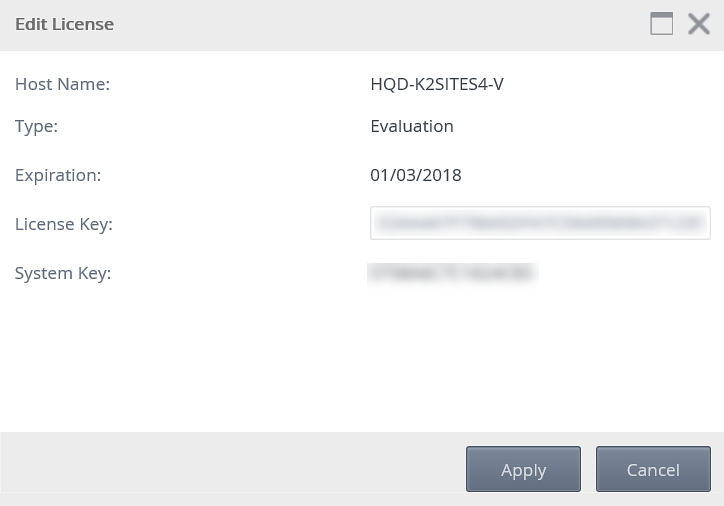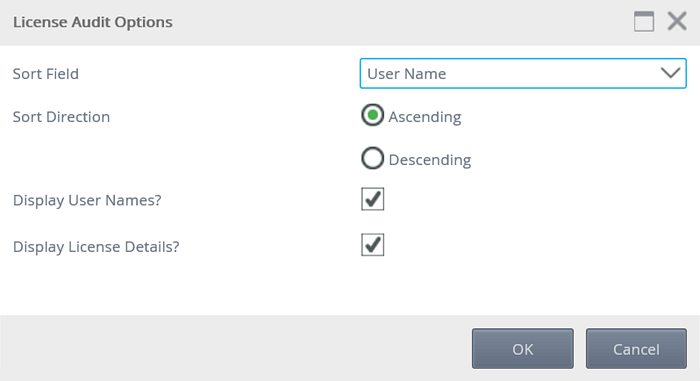Licenses
The Licenses node allows you to view and 
Considerations
- You must provide the system key when requesting a new license. Take care when copying the key, ensuring that no character is missed or extra space (treated as a character) is added to the copied string. If an incorrect digit is supplied or additional spaces are included, the system and license keys will be invalid.
- The system key is found from the K2 configuration manager, or from the Licenses node of the Management site.
- If the current license is still valid and you try to submit modified License details, K2 verifies that you have Administrator permissions before the license is updated. If the license is expired, any user can edit the License details and K2 will not perform the Administrator permission check, to allow the system to be brought back online quickly.
- Adding, editing or deleting a K2 License requires a restart of the K2 service. In a farm environment, you can use the management site to configure the license once for the environment, but you will then need to restart the K2 service on each server within the farm environment to apply the licensing changes.
- License keys can be obtained from the K2 customer and partner portal at http://portal.k2.com/
- Keep backup copies of your license keys before making changes to your server's license.
- If you are locked out of K2 Management due to an expired license, use the License Configuration page in the K2 Setup Manager to update your K2 license.
Licenses
The Licensing view allows you to add, edit and remove licenses, users as well as reset validation counts, generate the license audit and server usage reports. The licenses view also displays the amount of users, workflows and forms that can be created with your license. Use the server usage report to compare your license with deployed K2 artifacts and determine whether you are within your license agreement. 
| Field | Description |
|---|---|
| Add | Add a new K2 license. |
| Edit | Edit a license, for example updating an evaluation license to a full version. |
| Remove | Remove an existing license. |
| Refresh | Refresh the list of available licenses. |
| Reset Validation Count | Perform a reset of the validation count to "release" licenses consumed by users who should no longer consume K2 licenses. (Used in conjunction with the Users tab) |
| Audit Report | Generate a report on licensed users. |
| Server Usage Report | Generate a report on usage data by month. |
Follow these steps to add a license to your K2 environment. (You must request a license key using the system key to add a new license)
- Click Add on the Licenses page.

- The Add Licensepage opens.

Field Description Notes Product The product to be licensed Select a product from the list. System Key The system key uniquely identifies the individual machine. You must provide your system key to request a license. License Key The license key for the K2 Product to be registered. Enter the license key from the page used to request the new license or the license key returned in email by the licensing system. - Click Apply.
Follow these steps to edit a license. (You will have to obtain a license key for the system key to add a new license to your K2 environment)
- Select a license from the list in the Licenses view and click Edit .

- The Edit License page opens.

- Enter the new license key in the License Key field and click Apply.
Follow these steps to remove a license.
- Select a license from the list in the Licenses view and click Remove.

- On the Remove License? dialog, click OK to remove it.

Use the refresh button when a license has been added, edited or deleted, to refresh the list of licenses in the Licenses view and display reflect recent changes.
K2 keeps track of unique users who have connected to K2 to interact with workflows. Each unique user will "consume" a K2 license. The Reset Validation Count option allows you to extend an exceeded license, after you have cleaned out the Users table of users who should no longer "consume" a K2 license. The validation counter is a mechanism that only allows the number of users to log in that corresponds to the user licenses. When the validation count has been exceeded, the system will prompt you to enter a validation reset key.
- Select a license in the Licenses view and click Reset Validation Count.

- The Reset Exceeded License page opens.

- Enter the validation key in the License Key field and click Apply.
The Audit Report allows you to generate a report of active and inactive K2 users. An active user is a person who has opened a connection to K2. You must have Administrator rights to generate the report.
- Go to the K2 Management site and use the following path:
K2 Management > Licenses - Click Audit Report.

- The License Audit Options page opens.

Field Description Notes Sort Field Allows you to sort by user name, status, or last access date of the user Select a field from the list Sort Direction Sort by either ascending or descending order Display User Names? Displays user names in the report Uncheck this option if you do not want user names shown in the report Display License Details? Displays license details in the report Uncheck this option if you do not want license details shown in the report - Click OK.
-
Open the PDF by clicking the link or save it for later use.

- The report, by default, displays your license details and licensed users. The License Details section displays license information by License Type and Expiration Date. The Licensed Users section displays the number of active and inactive users followed by a list with the following columns:
- User: Displays the user's full names or GUID ID depending on whether the Display User Names? option was selected in the License Report Options page.
- Last Logged In: Displays the date the user last logged in to K2. This Last Logged In column can help you determine whether users have been inactive for periods of time. Contact the support team to remove inactive users to free up user licenses.
- Active: Displays active users with a green check and inactive users with a red cross.

Users
The Users view displays users who's credentials are cached (users who have connected to K2). From this page you are able to remove a user from the list. For a detailed list of user license seats occupied, see the Licenses section.

| Field | Description |
|---|---|
| Remove | Remove a selected user from the Users list. |
| Refresh | Refresh the Users list, when users have been removed. |
| Selected Filter | Select a default or custom filter to applied to the Users list. |
| Quick Search | Quick search using the default fields. |
| User | Displays a list of all user names. |
| State | Indicates whether a user is active or inactive. |
| Last Access Date | The last date the user was active on the environment. |
This option allows you to remove any users from your K2 environment. This frees up licenses for other users. Once you have removed a user, you may need to execute the Reset Validation Count command.
Follow these steps to remove a user from the Users list.
- Search or select a user from the Users list for removal. Click Remove.

- On the Remove Licensed User dialog click OK to confirm that you want to remove the user.

Server Usage Report
The Server Usage report allows you to view the number of K2 artifacts -- like workflow definitions, process instances, activity instances, event instances, SmartObjects, forms and views -- deployed in your environment. The purpose of this report is to compare this number with your license agreement. You can also use the license audit report and the server usage report to determine if you are compliant with your license agreement.
Considerations
- All data displayed begins when you first activated your license
- The data is also displayed in a cumulative format by month, allowing you to see how many new artifacts were deployed in that month. For example, let's say that in a previous month, 300 SmartObjects were deployed, and in the current month the count of SmartObjects deployed is 310. This means that 10 new SmartObjects were deployed this month.
- Copying a SmartObject adds to the count of deployed SmartObjects.

| Field | Description |
|---|---|
| Export Data button | Click the Export Data button to generate a PDF of the report |
| Refresh | Refreshes the report |
| Month | Displays the month of usage data |
| Workflow Definitions | Displays the number of total workflow definitions |
| Process Instances | Displays the number of process instances deployed |
| Activity Instances | Displays the number of activity instances deployed |
| Event Instances | Displays the number of event instances deployed |
| SmartObjects | Displays the number of SmartObjects deployed |
| Forms | Displays the number of forms deployed |
| Views | Displays the number of views deployed |
- Click Export Data.

- Open the PDF report by clicking the link or save the PDF report for later use.

- The report opens.
